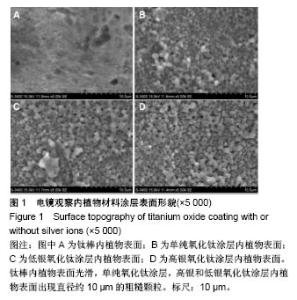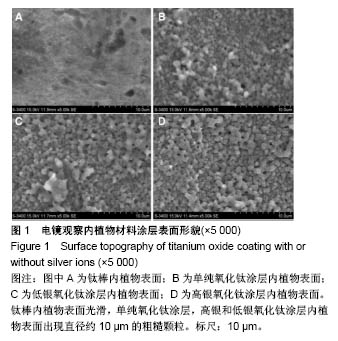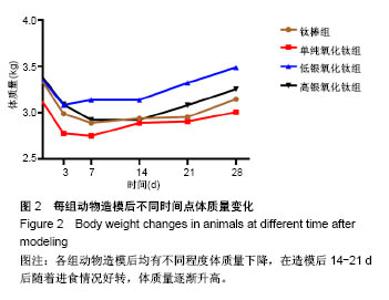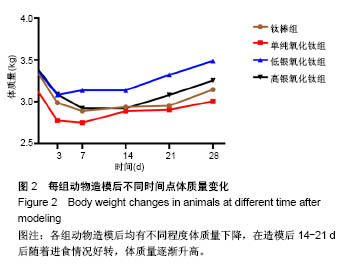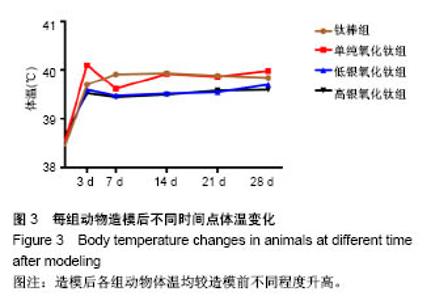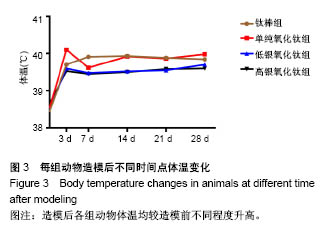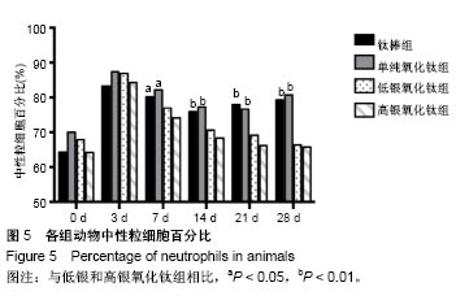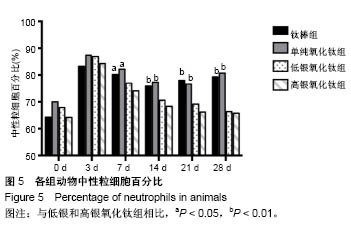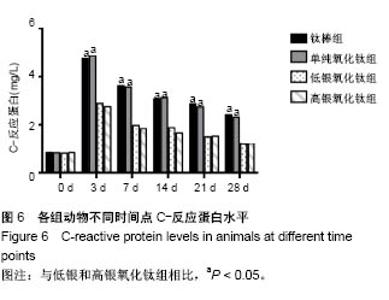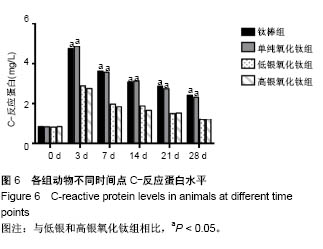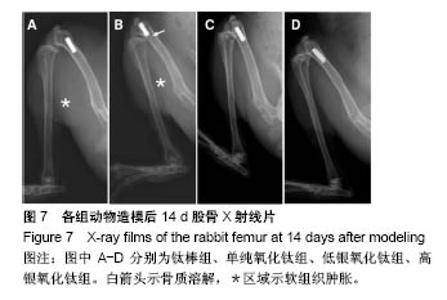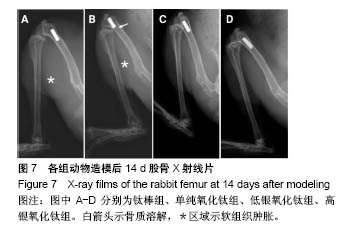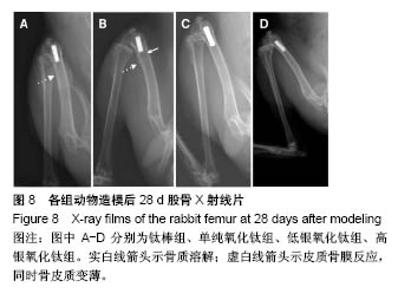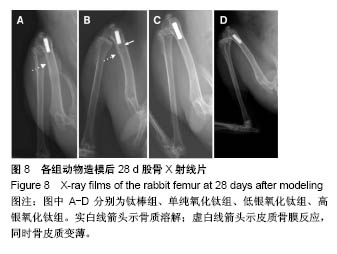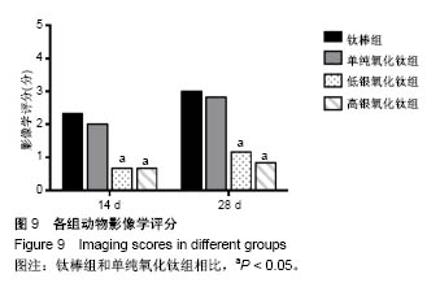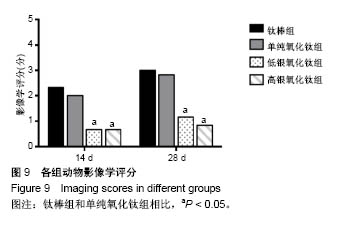Chinese Journal of Tissue Engineering Research ›› 2018, Vol. 22 ›› Issue (30): 4870-4875.doi: 10.3969/j.issn.2095-4344.0988
Previous Articles Next Articles
Antibacterial properties of titanium oxide coating with silver ions
Li Gen1, 2, Song Hui1, Wang Yi-han1, Zhao Wen-bo1, Dai Ying1, Guo Yinghuimin1, Dong Yu-qi1, Zhang Chao1
- 1Department of Traumatic Orthopaedics, Renji Hospital, School of Medicine, Shanghai Jiao Tong University, Shanghai 200127, China; 2Department of Orthopaedics, Tenth People’s Hospital of Tongji University, Shanghai 200072, China
-
Received:2018-05-16Online:2018-10-28Published:2018-10-28 -
Contact:Zhang Chao, MD, Associate chief physician, Department of Traumatic Orthopaedics, Renji Hospital, School of Medicine, Shanghai Jiao Tong University, Shanghai 200127, China -
About author:Li Gen, Doctorate candidate, Department of Traumatic Orthopaedics, Renji Hospital, School of Medicine, Shanghai Jiao Tong University, Shanghai 200127, China; Department of Orthopaedics, Tenth People’s Hospital of Tongji University, Shanghai 200072, China -
Supported by:the Funded Project of Shanghai Municipal Health and Family Planning Commission, No. 201440268
CLC Number:
Cite this article
Li Gen, Song Hui, Wang Yi-han, Zhao Wen-bo, Dai Ying, Guo Yinghuimin, Dong Yu-qi, Zhang Chao. Antibacterial properties of titanium oxide coating with silver ions[J]. Chinese Journal of Tissue Engineering Research, 2018, 22(30): 4870-4875.
share this article
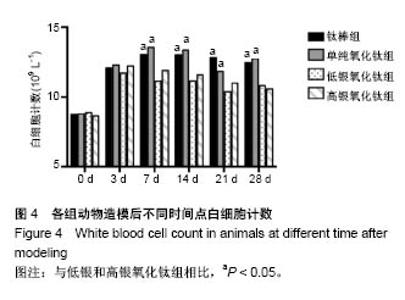
2.4 血液学检测 白细胞计数及中性粒细胞百分比:造模后4组动物白细胞计数均有不同程度升高(P < 0.05)且持续至造模后28 d。造模后3 d至处死前,低银和高银氧化钛组白细胞计数逐渐减少,而钛棒组和单纯氧化钛组白细胞计数仍处于较高水平。组间比较造模后3 d,各组兔白细胞计数无显著性差异,造模后7,14,21,28 d,钛棒组和单纯氧化钛组白细胞计数均显著高于低银和高银氧化钛组 (P < 0.05),而钛棒组和单纯氧化钛组相比无显著性差异(图4)。造模后3,7,14 d各组动物中性粒细胞百分比与造模前相比均升高(P < 0.05),造模后21,28 d钛棒组和单纯氧化钛组中性粒细胞百分比与造模前相比仍增高(P < 0.05);而低银和高银氧化钛组中性粒细胞百分比与造模前无显著性差异。组间比较造模后3 d,各组性粒细胞百分比无显著性差异;造模后7 d单纯氧化钛组中性粒细胞百分比均显著高于低银和高银氧化钛组(P < 0.05);造模后14,21,28 d,钛棒组和单纯氧化钛组中性粒细胞百分比显著高于低银和高银氧化钛组(P < 0.01);各时间点钛棒组和单纯氧化钛组之间中性粒细胞百分比无显著性差异。 C-反应蛋白:各组组动物C-反应蛋白水平于造模后 3 d达到峰值,之后逐渐下降,但造模后28 d与造模前相比仍处于较高水平(P < 0.05)。造模后3,7,14,21,28 d,钛棒组和单纯氧化钛组C-反应蛋白显著高于低银和高银氧化钛(P < 0.05)。钛棒组和单纯氧化钛组、低银和高银氧化钛组之间无显著性差异(图6)。"
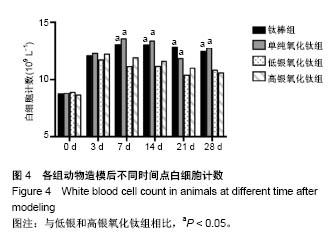
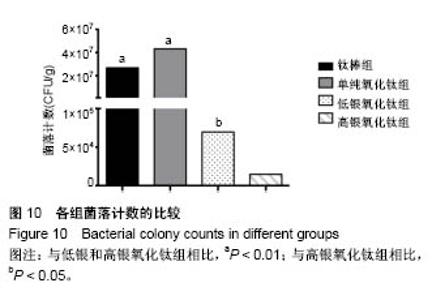
2.6 标本含菌量检测 造模后4周处死各组所有实验动物,无菌条件下取右侧股骨。其中钛棒组5只、单纯氧化钛组6只低银氧化钛组1只、高银氧化钛组2只可见不同程度关节周围软组织肿胀,挤压软组织后可见黄白色脓液或凝固性坏死物。股骨表面可见不同程度骨质变形,局限性不规则隆起。每组随机选取5个标本进行含菌量检测,钳碎股骨过程中可见髓腔内坏死物及黄白色脓性物质。骨组织细菌培养,通过革兰染色及血浆凝固酶试验确定所培养细菌均为金黄色葡萄球菌。细菌培养菌落计数显示,钛棒组和单纯氧化钛组菌落计数显著高于低银和高银氧化钛组(P < 0.01);低银氧化钛组显著高于高银氧化钛组(P < 0.05);钛棒组和单纯氧化钛组间无显著性差异,见图10。"
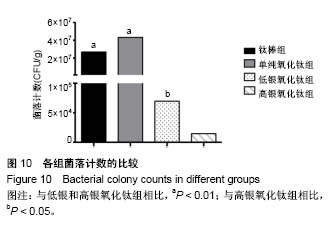
| [1] Schierholz JM, Beuth J. Implant infections: a haven for opportunistic bacteria. J Hosp Infect. 2001; 49(2):87-93.[2] Hwang CM, Lee BK, Green D, et al. Auricular reconstruction using tissue-engineered alloplastic implants for improved clinical outcomes. Plast Reconstr Surg. 2014;133(3):e360-369.[3] Murphy EH, Szeto WY, Herdrich BJ, et al. The management of endograft infections following endovascular thoracic and abdominal aneurysm repair. J Vasc Surg. 2013;58(5):1179-1185.[4] Bozic KJ, Lau E, Kurtz S, et al. Patient-related risk factors for periprosthetic joint infection and postoperative mortality following total hip arthroplasty in Medicare patients. J Bone Joint Surg Am. 2012;94(9): 794-800.[5] Bozic KJ, Lau E, Kurtz S, et al. Patient-related risk factors for postoperative mortality and periprosthetic joint infection in medicare patients undergoing TKA. Clin Orthop Relat Res. 2012; 470(1):130-137.[6] Chen WH, Jiang LS, Dai LY. Influence of bacteria on spinal implant-centered infection: an in vitro and in vivo experimental comparison between Staphylococcus aureus and mycobacterium tuberculosis. Spine. 2011; 36(2):103-108.[7] Zimmerli W. Clinical presentation and treatment of orthopaedic implant-associated infection. J Intern Med. 2014;276(2): 111-119.[8] Semeykina AL, Skulachev VP. Submicromolar Ag+ increases passive Na+ permeability and inhibits the respiration-supported formation of Na+ gradient in Bacillus FTU vesicles. FEBS Lett. 1990; 269(1): 69-72.[9] 王静水,冀志江,等.银系无机抗菌材料研究进展.材料导报[J],2013,27(17): 59-64.[10] Taheri S, Cavallaro A, Christo SN, et al. Substrate independent silver nanoparticle based antibacterial coatings. Biomaterials. 2014;35(16): 4601-4609.[11] Reithofer MR, Lakshmanan A, Ping AT, et al. In situ synthesis of size-controlled, stable silver nanoparticles within ultrashort peptide hydrogels and their anti-bacterial properties. Biomaterials. 2014;35(26): 7535-7542.[12] Zhao L, Wang H, Huo K, et al. Antibacterial nano-structured titania coating incorporated with silver nanoparticles. Biomaterials. 2011;32(24): 5706-5716.[13] Arora S, Tyagi N, Bhardwaj A, et al. Silver nanoparticles protect human keratinocytes against UVB radiation-induced DNA damage and apoptosis: potential for prevention of skin carcinogenesis. Nanomedicine. 2015; 11(5):1265-1275.[14] Zhang T, Wang L, Chen Q, et al. Cytotoxic potential of silver nanoparticles. YMJ. 2014; 55(2):283-291.[15] Park EJ, Yi J, Kim Y, et al. Silver nanoparticles induce cytotoxicity by a Trojan-horse type mechanism. Toxicol In Vitro. 2010; 24(3):872-878.[16] Li B, Liu X, Cao C, et al. Biological and antibacterial properties of plasma sprayed wollastonite coatings grafting gentamicin loaded collagen. J Biomed Mater Res A. 2008;87(1):84-90.[17] Postiglione L, Di Domenico G, Ramaglia L, et al. Different titanium surfaces modulate the bone phenotype of SaOS-2 osteoblast-like cells. Eur J Histochem.2004; 48(3):213-222.[18] Rautray TR, Narayanan R, Kim KH. Ion implantation of titanium based biomaterials. Prog Mater Sci. 2011;56(8):1137-1177.[19] Rautray TR, Narayanan R, Kwon TY, et al. Surface modification of titanium and titanium alloys by ion implantation. J Biomed Mater Res A. 2010; 93(2):581-591.[20] Kose N, Otuzbir A, Peksen C, et al. A silver ion-doped calcium phosphate-based ceramic nanopowder-coated prosthesis increased infection resistance. Clin Orthop Relat Res. 2013;471(8):2532-2539.[21] Norden CW. Lessons learned from animal models of osteomyelitis. Rev Infect Dis. 1988; 10(1):103-110.[22] Norden CW, Myerowitz RL, Keleti E. Experimental osteomyelitis due to Staphylococcus aureus or Pseudomonas aeruginosa: a radiographic- pathological correlative analysis. Br J Exp Pathol. 1980;61(4):451-460.[23] Tian Y, Cao H, Qiao Y, et al. Antibacterial activity and cytocompatibility of titanium oxide coating modified by iron ion implantation. Acta Biomater. 2014; 10(10):4505-4517.[24] Mauerer A, Lange B, Welsch GH, et al. Release of Cu2+ from a copper-filled TiO2 coating in a rabbit model for total knee arthroplasty. J Mater Sci Mater Med. 2014; 25(3):813-821.[25] Wang G, Mao Z, Zhang L, et al. Meta-analysis of locking plate versus intramedullary nail for treatment of proximal humeral fractures. J Orthop Surg Res. 2015; 10:122.[26] Deye GA, Gettayacamin M, Hansukjariya P, et al. Use of a rhesus Plasmodium cynomolgi model to screen for anti-hypnozoite activity of pharmaceutical substances. AM J Trop Med Hyg.2012; 86(6):931-935.[27] Holt KB, Bard AJ. Interaction of silver(I) ions with the respiratory chain of Escherichia coli: an electrochemical and scanning electrochemical microscopy study of the antimicrobial mechanism of micromolar Ag+. Biochemistry. 2005;44(39):13214-13223.[28] Yang X, Yang W, Wang Q, et al. Atomic force microscopy investigation of the characteristic effects of silver ions on Escherichia coli and Staphylococcus epidermidis. Talanta. 2010;81(4-5):1508-1512.[29] Qin H, Cao H, Zhao Y, et al. In vitro and in vivo anti-biofilm effects of silver nanoparticles immobilized on titanium. Biomaterials. 2014;35(33):9114-9125.[30] Spangehl MJ, Masri BA, O'Connell JX, et al. Prospective analysis of preoperative and intraoperative investigations for the diagnosis of infection at the sites of two hundred and two revision total hip arthroplasties. J Bone Joint Surg Am. 1999;81(5):672-683. |
| [1] | Zhang Tongtong, Wang Zhonghua, Wen Jie, Song Yuxin, Liu Lin. Application of three-dimensional printing model in surgical resection and reconstruction of cervical tumor [J]. Chinese Journal of Tissue Engineering Research, 2021, 25(9): 1335-1339. |
| [2] | Yuan Jiawei, Zhang Haitao, Jie Ke, Cao Houran, Zeng Yirong. Underlying targets and mechanism of Taohong Siwu Decoction in prosthetic joint infection on network pharmacology [J]. Chinese Journal of Tissue Engineering Research, 2021, 25(9): 1428-1433. |
| [3] | Zeng Yanhua, Hao Yanlei. In vitro culture and purification of Schwann cells: a systematic review [J]. Chinese Journal of Tissue Engineering Research, 2021, 25(7): 1135-1141. |
| [4] | Hua Haotian, Zhao Wenyu, Zhang Lei, Bai Wenbo, Wang Xinwei. Meta-analysis of clinical efficacy and safety of antibiotic artificial bone in the treatment of chronic osteomyelitis [J]. Chinese Journal of Tissue Engineering Research, 2021, 25(6): 970-976. |
| [5] | Xu Dongzi, Zhang Ting, Ouyang Zhaolian. The global competitive situation of cardiac tissue engineering based on patent analysis [J]. Chinese Journal of Tissue Engineering Research, 2021, 25(5): 807-812. |
| [6] | Li Xingping, Xiao Dongqin, Zhao Qiao, Chen Shuo, Bai Yiguang, Liu Kang, Feng Gang, Duan Ke. Preparation and properties of copper-loaded antibacterial functional film on titanium surface [J]. Chinese Journal of Tissue Engineering Research, 2021, 25(4): 553-557. |
| [7] | Wu Zijian, Hu Zhaoduan, Xie Youqiong, Wang Feng, Li Jia, Li Bocun, Cai Guowei, Peng Rui. Three-dimensional printing technology and bone tissue engineering research: literature metrology and visual analysis of research hotspots [J]. Chinese Journal of Tissue Engineering Research, 2021, 25(4): 564-569. |
| [8] | Shi Xiaoxiu, Mao Shilong, Liu Yang, Ma Xingshuang, Luo Yanfeng. Comparison of tantalum and titanium (alloy) as orthopedic materials: physical and chemical indexes, antibacterial and osteogenic ability [J]. Chinese Journal of Tissue Engineering Research, 2021, 25(4): 593-599. |
| [9] | Chang Wenliao, Zhao Jie, Sun Xiaoliang, Wang Kun, Wu Guofeng, Zhou Jian, Li Shuxiang, Sun Han. Material selection, theoretical design and biomimetic function of artificial periosteum [J]. Chinese Journal of Tissue Engineering Research, 2021, 25(4): 600-606. |
| [10] | Liu Fei, Cui Yutao, Liu He. Advantages and problems of local antibiotic delivery system in the treatment of osteomyelitis [J]. Chinese Journal of Tissue Engineering Research, 2021, 25(4): 614-620. |
| [11] | Li Xiaozhuang, Duan Hao, Wang Weizhou, Tang Zhihong, Wang Yanghao, He Fei. Application of bone tissue engineering materials in the treatment of bone defect diseases in vivo [J]. Chinese Journal of Tissue Engineering Research, 2021, 25(4): 626-631. |
| [12] | Zhang Zhenkun, Li Zhe, Li Ya, Wang Yingying, Wang Yaping, Zhou Xinkui, Ma Shanshan, Guan Fangxia. Application of alginate based hydrogels/dressings in wound healing: sustained, dynamic and sequential release [J]. Chinese Journal of Tissue Engineering Research, 2021, 25(4): 638-643. |
| [13] | Chen Jiana, Qiu Yanling, Nie Minhai, Liu Xuqian. Tissue engineering scaffolds in repairing oral and maxillofacial soft tissue defects [J]. Chinese Journal of Tissue Engineering Research, 2021, 25(4): 644-650. |
| [14] | Ma Rui, Wang Jialin, Wu Mengjun, Ge Ying, Wang Wei, Wang Kunzheng. Relationship of pathogenic bacteria distribution with drug resistance and treatment cycle for periprosthetic joint infection after total joint arthroplasty [J]. Chinese Journal of Tissue Engineering Research, 2021, 25(3): 380-385. |
| [15] | Xing Hao, Zhang Yonghong, Wang Dong. Advantages and disadvantages of repairing large-segment bone defect [J]. Chinese Journal of Tissue Engineering Research, 2021, 25(3): 426-430. |
| Viewed | ||||||
|
Full text |
|
|||||
|
Abstract |
|
|||||
